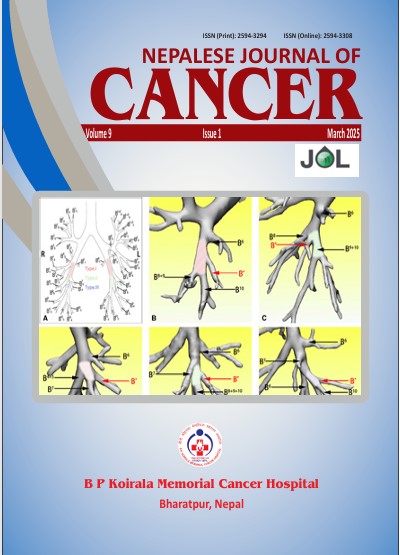Wound Complications after Inguinal lymph node dissections for Penile cancers
DOI:
https://doi.org/10.3126/njc.v9i1.77093Keywords:
Lymphocele, Wound Complications,, Penile Cancer, Lymph Node DissectionAbstract
Background: Penile cancer in higher stages are treated by inguinal lymph node dissection (ILND). However, ILND is frequently associated with its morbidity of wound complication rates. Wound infection, seroma, skin-flap necrosis, and wound dehiscence are some of early complications. The aim of this study is to investigate the incidence, risk factors, management strategies, and impact on patient outcomes of wound complications after ILND for penile cancer.
Materials and Methods: Data of 30 consecutively enrolled patients with penile cancer admitted in department of Surgical Oncology, Urology Unit at B. P. Koirala Memorial Cancer Hospital who underwent ILND during the period form 15th May 2024 to 15th December 2024 were included in the study. The different variable like baseline patient characteristics: age, history of diabetes, smoking, chronic obstructive pulmonary disease (COPD), Hypertension and American Society of Anesthesiologist (ASA) score were reviewed and recorded. The intraoperative and postoperative parameters like Operative time, length of stay, deep venous thrombosis, wound infection, skin-flap problems, and lymphocele were reviewed and recorded. Data was collected and analyzed using SPSS version 25.
Result: Total 30 patients of penile cancer underwent Open ILND during the period. Total 22 (73.33%) patients developed some form of wound complications after ILND. Among them, 16 (53.33%) patients developed minor skin edge necrosis, 10 (33.33%) patients had wound infection, 5 (17%) patients subsequently developed some degree of wound dehiscence and 1 (3.33%) patient had postoperative hematoma.
Conclusion: Inguinal Lymph Node Dissection for the management of penile cancer is associated with high rate of wound complications secondary to wound infection, wound dehiscence, lymphocele, lymphedema and hematoma
Downloads
Downloads
Published
How to Cite
Issue
Section
License
Copyright (c) 2025 Nepalese Journal of Cancer

This work is licensed under a Creative Commons Attribution 4.0 International License.
This license lets others distribute, remix, tweak, and build upon your work, even commercially, as long as NJC and the authors are acknowledged.
Submission of the manuscript means that the authors agree to assign exclusive copyright to NJC. The aim of NJC is to increase the visibility and ease of use of open access scientific and scholarly articles thereby promoting their increased usage and impact.




